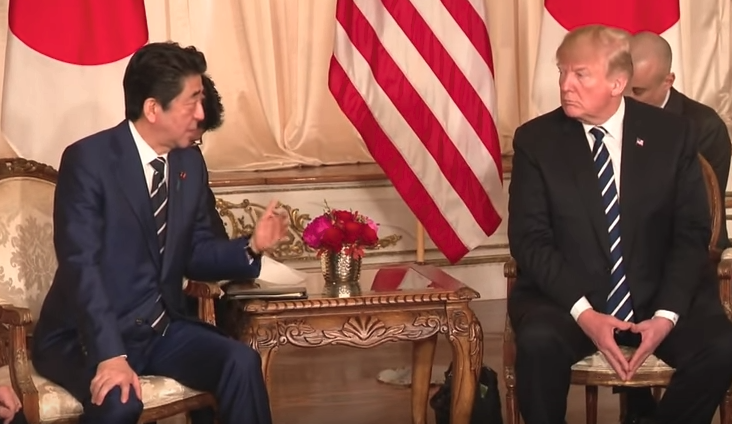
Just when he thought he was out, they pull him back in. Maybe.
President Donald Trump made waves on the first full workday of his presidency by withdrawing from the Trans-Pacific Partnership (TPP). Now, it appears that Trump may wish to re-enter the deal, although the value of doing so is questionable if its terms are not re-negotiated (more on that in a bit).
We put together a helpful timeline to chronicle The Donald's many stances on the trade deal, which we hope you find useful as you follow the TPP debate.
April 22, 2015
Trump criticizes the TPP in a multi-part tweetstorm, panning its insufficient currency manipulation enforcement as detrimental to the American workers.
The Trans-Pacific Partnership is an attack on America's business. It does not stop Japan's currency manipulation. This is a bad deal.
— Donald J. Trump (@realDonaldTrump) April 22, 2015
Republicans should not be giving Obama fast track authority on trade. The Trans-Pacific Partnership will squeeze our manufacturing sector
— Donald J. Trump (@realDonaldTrump) April 22, 2015
The Trans-Pacific Partnership will lead to even greater unemployment. Do not pass it.
— Donald J. Trump (@realDonaldTrump) April 22, 2015
China has a backdoor into the Trans-Pacific Partnership. This deal does not address currency manipulation. China is laughing at us.
— Donald J. Trump (@realDonaldTrump) April 22, 2015
June 28, 2016
Trump’s trade rhetoric throughout his presidential campaign consistently criticizes the TPP, with the candidate calling it the “death blow for America manufacturing” on June 28, 2016 in a campaign speech. The Republican presidential nominee tells supporters in Monessen, Pa.:
"The TPP would be the death blow for American manufacturing … It would further open our markets to aggressive currency cheaters. It would make it easier for our trading competitors to ship cheap subsidized goods into U.S. markets – while allowing foreign countries to continue putting barriers in front of our exports."
Later that day, Trump draws controversy when he says in a speech in Clairsville, Ohio that the "Trans-Pacific Partnership is another disaster done and pushed by special interests who want to rape our country — just a continuing rape of our country."
January 23, 2017
Newly sworn-in, President Trump signs an executive order withdrawing the United States from the TPP, although it's worth pointing out that Congress was unlikely to have passed it. The issue seems settled, until…
January 25, 2018
…almost exactly one year later, when Trump states that he would consider rejoining the TPP if it were made a “substantially better” agreement for the United States. Trump tells CNBC during an interview at the World Economic Forum in Davos, Switzerland:
"I would do TPP if we were able to make a substantially better deal. The deal was terrible, the way it was structured was terrible. If we did a substantially better deal, I would be open to TPP."
April 12, 2018
Trump sends shockwaves through Washington when he asks Chief Economic Adviser Larry Kudlow and U.S. Trade Representative Robert Lighthizer to explore re-entering the TPP, but reiterates his preference for bilateral trade deals in a tweet posted later in the evening.
Would only join TPP if the deal were substantially better than the deal offered to Pres. Obama. We already have BILATERAL deals with six of the eleven nations in TPP, and are working to make a deal with the biggest of those nations, Japan, who has hit us hard on trade for years!
— Donald J. Trump (@realDonaldTrump) April 13, 2018
April 17, 2018
Reiterating his preference for bilateral trade deals, Trump tweets that the TPP would not as effectively address trade concerns.
While Japan and South Korea would like us to go back into TPP, I don’t like the deal for the United States. Too many contingencies and no way to get out if it doesn’t work. Bilateral deals are far more efficient, profitable and better for OUR workers. Look how bad WTO is to U.S.
— Donald J. Trump (@realDonaldTrump) April 18, 2018
April 18, 2018
In a joint press conference with Japanese Prime Minister Shinzo Abe, held during Abe’s visit to Mar-a-Lago, Fla.,Trump states that he is “committed to pursuing a bilateral trading relationship that benefits both of our great countries.” Trump says:
"We’re also working to improve our economic partnership by reducing our trade imbalance and removing barriers to U.S. exports. The United States is committed to free, fair, and reciprocal — very important word — trade. And we’re committed to pursuing a bilateral trading relationship that benefits both of our great countries."
Trump's preference for a bilateral agreement is notable, as Abe had pressed him to rejoin the TPP. In any case, the two countries agreed to hold additional talks on trade issues.
If Trump chooses to proceed exploring re-entering the TPP, he has the opportunity to improve the deal to level the playing field for workers in America. The original TPP did little to address the following concerns:
- Currency manipulation was largely overlooked in the TPP, which failed to offer any enforceable provisions for this ploy to artificially boost exports.
- The TPP’s rules of origin were riddled with a multitude of exemptions and exclusions that undermined its efficacy and offered opportunities for countries outside the TPP, like China, to evade tariffs in delivering goods to TPP countries.
- State-owned enterprises (SOEs), businesses that benefit from substantial financial support from their parent states, have an unquestionably unfair advantage over businesses that must compete in a free market. Although China’s steel industry offers examples of notorious SOEs, TPP included other SOE countries, such as Vietnam and Malaysia, that could disrupt fair trade.
It’s unclear whether Trump will pursue re-joining the TPP or adhere to a bilateral deal, but workers and manufacturers deserve to be thought of first and foremost in all trade negotiations.
